- Popular Post

kscarbel2
-
Posts
17,802 -
Joined
-
Days Won
85
Content Type
Profiles
Forums
Gallery
Events
Blogs
BMT Wiki
Collections
Store
Posts posted by kscarbel2
-
-
Diesel News / October 31, 2013
Scania’s limited edition “Black Amber” R-series V-8 tractors are bringing a golden glow to the roads of Western Australia.
Perth-based Scania customers have purchased both the R730 and R620 V8-powered Black Amber tractors imported into Australia for their debut at the Brisbane and Perth truck shows this year.
Greg Goodchild from Greg’s Meat Transport bought the R730, and David Edghill from Express Freezer Transport purchased the R620.
Greg’s Meat Transport runs a mixed fleet of more than 50 trucks, six of which are Scanias. Greg has added two R560 V-8 6x4s and the Black Amber V-8 this year, with two P360 8×2 rigids scheduled for delivery in 2014.
“I have been in the transport industry for 36 years and the Black Amber is the best vehicle I have ever seen,” Greg says.
“I have always wanted a truck like this, and as soon as I saw it at the Perth Truck Show and looked inside it, I knew I had to have one.
“The truck is already on the road, being driven by Greg Howard, one of my long-time drivers. He is fanatical about keeping it clean. His SUV even carries a water-filled tank that he uses to wash the truck. He’s got towels all over the inside to keep it pristine.”
Although Greg’s Meat Transport specializes in the refrigerated transport of a wide range of meat products, the Black Amber is hooked up to B-double containing supermarket groceries. Each day it plies the Forrest Highway to Bunbury and back, from the company’s base in Jandakot, Perth.
“We are getting excellent fuel from the truck, better performance than we expected, in fact,” Greg says.
“The response from other drivers on the road, and just anyone who sees it is phenomenal. It has been a great image-builder for our business, too, and I reckon it will help us attract good drivers in the future,” Greg says.
“We started buying Scanias because we had a good recommendation from another transport operator who has run them. We really like the quality of build and the backup from Scania, because you’re dealing with the factory. The team at Scania Bunbury is particularly good, and so I will have the Black Amber serviced by them. They’re always on the ball,” he says.
Express Freezer Transport (EFT) has 10 trucks – eight of which are Scanias. Their trucks are also used in the distribution of fresh produce for supermarkets. EFT has purchased three new Scanias this year: a P440 6×2 tractor, the R620 V-8 Black Amber, and a soon-to-be-delivered R480 6×2 tractor.
“The first truck I bought was a Scania, a second-hand 82M rigid, and my first new truck was a Scania a 4-series, a 94 310 hp 4×2,” David says.
The Express Freezer Transport R620 V-8 Black Amber is pulling a sharp new 49 ft. jumbo slider-side single refrigerated trailer that complements its stunning looks.
“That’s my truck,” David says definitively, when asked about the new Black Amber.
“I drive it most of the time and when I don’t, the driver who gets the text message that says he’ll be driving it the next day has a very big smile.
“It’s a beautiful truck to go to work in everyday,” David says.
“In the first week of driving Black Amber, three guys came up and offered to come to work for me, just because we had it on the fleet. I reckon the Black Amber definitely elevates our profile. It says something positive about you as a transport operator.
“The Black Amber is such a distinctive truck, wherever we go not only do the fork lift drivers and dispatchers stop work to look at it, and pop their heads inside, but the office girls come out to see what all the fuss is about too.
“It’s like dating a movie star. I expected other drivers would be interested in it, but everyone wants to look at it,” he says.
David is not only a long-time Scania owner, he is also sold on Scania Maintenance and Repair Programs, which means his trucks will always be in prime condition.
“All our trucks work six or seven days a week, but cover only around 80,000 km a year because we are delivering around the metro area. But they are hard kilometers, which is why I have these three new trucks on the Scania Maintenance and Repair Program.
“It’s a no brainer for me because to be successful as a transport operator you have to know your costs as accurately as possible and control them.
“You need to be able to keep to your budget or know when you are not, so you can take action and adjust your prices to be in line with your costs.
“It’s about managing risk, so with the Maintenance and Repair Program, the risk is carried by Scania over 1,000 trucks, rather than my business across my 10 trucks,” he says.
The Scania Black Amber Limited Edition trucks were created by Svempa, one of Scania’s long-time collaborators in the production of eye-catching trucks.
In addition to the Black Amber metallic paint that really glows in direct sunlight, there are carbon-fiber look flames racing up the side of the vehicle, complementing the bold Black Amber name badge adorning the front of the Highline Cab.
The special truck has black and chrome highlight wheels and plenty of piano black gloss trim, and inside the luxury continues with premium, perforated leather upholstery, a wood-and-leather-rimmed steering wheel and special carpets, while a large wooden commemorative plaque is fixed to the back wall.
-
 2
2
-
-
-
Wörth / Molsheim
October 30, 2013
Mercedes-Benz’s Custom Tailored Truck (CTT) unit has expanded its offerings with the addition of 5-axle vocational chassis. Located in Molsheim, Germany, the CTT modifications center converts a standard Arocs chassis from the Wörth plant into a 5-axle variant. CTT handles development, production, sales marketing and service documentation, providing customers with a seamless solution.
End customers benefit from the fact that the trucks converted by CTT enjoy the same high Mercedes-Benz standards of quality as regular production vehicles, and the same warranty and after-sales support.
Custom-built trucks from Mercedes-Benz’s Custom Tailored Truck (CTT) unit are supported by Mercedes-Benz’s worldwide network of service locations. The Mercedes-Benz parts and service system provides detailed information on the full scope of the conversion including what parts were used.
With twin steer axles and a steerable tag axle, 5-axle trucks are very popular across Europe. In Switzerland, 5-axle rigid trucks are permitted to carry a gross vehicle weight of 88,185 pounds (40 tons). In the Netherlands, a gross vehicle weight of 110,231 pounds (50 tons) is permitted for 5-axle rigid trucks.
The new 40 ton-rated (88,185 pounds) 5-axle Arocs vocational chassis is purpose-designed for the construction industry. The Arocs is fitted with the “ClassicSpace” cab and has a wheelbase of 4250 mm (167.3 inches).
The 5-axle conversion involves adding a 9-ton liftable air-suspended tag axle to a standard 4-axle chassis with twin-steer front axles rated at 7.5 and 9 tons respectively (16,535 lb and 19,842 lb) and two air-suspended drive axles rated at 11.5 tons each (48,502 lb bogie). The added steered and liftable tag axle increases the chassis’ legal GVW to 88,185 pounds (40 tons).
With a total of three steered axles, the turning circle is reduced to 64 feet (19.6 meter) and a standard Arocs 8x4/4 becomes an Arocs 10x4/4. The chassis now has a technical off-road GVW capability of 97,003 pounds (44 tons).
As part of the 5-axle conversion, chassis modifications included relocation of the AdBlue tank and air reservoirs, and alteration of the standard fuel tank design for greater capacity and additional ground clearance.
From a very early stage, bodybuilders including dump body and concrete mixer manufacturers Meiller and Liebherr played an integral part in the development process. The modified chassis is built from the start with outstanding body-mounting ability, resulting in less cost-intensive and time-consuming dump and mixer body mounting.
-
 2
2
-
-
Fleet Owner / October 31, 2013
A new drain pan from Ken-Tool catches gear oil and grease drips before they fall onto wheels, tires and shop floors.
The model 30600 axle drain pan is attached to the wheel using two or three lug studs with finger-tightened nuts. The lightweight, high-density polyethylene (HDPE) pan is contoured to rest flat with the sides gripping the wheel’s drop-center. The pan fits most 22.5- and 24.5-in., 10-hole hub or stud-piloted steel or alloy super single, wide-base and dual wheels.
The pan features a pair of self-draining shelves for placement of hub covers, bearings, retainers, seals and hub or axle nuts. It holds up to 124 fluid ounces and features two drip-proof drain spouts for easy waste disposal.
The HDPE plastic resists heat and warping, and deep sides and flat bottom prevent accidental spills on the floor or a work bench.
.
-
 1
1
-
-
- Popular Post
- Popular Post
-
- Popular Post
- Popular Post
The U.S. Army has for decades purchased mobile dynamometers. By generating tractive rolling resistance (power absorption), the dynamometer is able to test the tractive effort of both wheeled and tracked vehicles.
Delivered to the Ordinance Department of the U.S. Army at Aberdeen Proving Ground in September 1940, the Mack Trucks M5 was based on a model FKSW 6x4 chassis powered by a 707 cu.in. 178 horsepower Mack model EY gasoline engine. The truck’s special retardation ability was accomplished by utilizing two Hale model MCT-8S 750GPM positive displacement pressure pumps. The Mack M5 weighed 50,000 pounds and could develop a retardation capability of 20,000 pounds.
Pleased with Mack’s engineering, the U.S. Army ordered an additional 6x4 dynamometer from Mack Trucks within one year of the M5. The Mack M6 was based on a model LPSW 6x4 chassis, and featured an upgraded version of Mack’s proven 707 cu.in. model EY gasoline engine now rated at 195 horsepower. Like the M5, the Mack M6 weighed 50,000 pounds and had a retardation capability of 20,000 pounds.
Both the Mack M5 and M6 were paired with Mack-designed and built power absorption (retardation) trailers which could add an additional 15,000 pounds of retardation.
During the 1960s, the U.S. Army had Mack Trucks create a dynamometer based on the Mack M125 tactical cargo chassis. Little is publicly known about it. This picture was taken at Fort Belvoir in 1983. While standard M125s had an open-type tactical cab, this unit was custom-fitted with an enclosed cab to meet the Army’s requirement.
Today, the Aberdeen Test Center continues to operate two mobile dynamometers, the M16 and M18 produced by Barnes and Reinecke.
The 1978 vintage “heavy” M16 dynamometer’s power package utilizes a GM-EMD (General Motors – Electro-Motive Diesel) model EMD8-645E4 turbocharged diesel engine rated at 1,650 horsepower coupled to a GM-EMD model AR5 3-phase AC current generator. The power developed drives two GM-EMD model D79-F series wound four-pole direct current traction motors.
The late eighties vintage “medium“ M18 dynamometer’s power package utilizes a Cummins model KTA-19P600 turbocharged diesel engine rated at 600 horsepower coupled to a General Electric model 603 3-phase AC current generator. The power developed drives one General Electric model 5GE773DS2 series wound four-pole direct current traction motor.
(For those interested, this 2012 year PDF elaborates on the U.S. Army's Aberdeen, Maryland and Yuma, Arizona vehicle test facilities - http://www.dtic.mil/dtic/tr/fulltext/u2/a557002.pdf. The M16 and M18 are shown on page 18.)
In addition, the U.S. Army’s Tank, Automotive, Research, Development and Engineering Center (TARDEC) has built a one-of-a-kind Power and Energy Vehicle and Environmental Lab (PEVEL) at the Detroit Arsenal which has 12 dynamometers paired with an environmental chamber that can generate up to 95 percent relative humidity, create wind speeds up to 60-mph, and simulate temperatures from -60°F up to 160°F.
.
-
 2
2
-
 2
2
-
-
There is a little confusion above about Anzio and Normandy.
Please forgive me. I'm going to blame it on jet lag. I corrected it.
-
- Popular Post
There was a time when America's truckmakers led the world in technology. The Europeans were clearly behind us in every aspect of truck design. America's most cutting edge truckmaker, Mack Trucks, for decades put the world on notice that U.S. heavy truck design was second to none.
And yet look at where we stand today. For a country in which trucking figures so prominently, it is a tragedy that all the trucks on the roads of America today, with the exception of Navistar and Paccar, are produced by the Germans and Swedes. It is a national disgrace that America no longer has the ability to compete and lead in our own domestic truck market.
We are the greatest nation in the world, and yet we have allowed our trucking industry to be sold out to and controlled by the Europeans. If our industrial might and abilty for cutting edge innovation is now resigned to the history books, we should all take lessons in humility.
-
 4
4
-
 1
1
-
- Popular Post
-
- Popular Post
- Popular Post
-
Speaking of the Kenworth-produced M249 (front unit) and M250 (rear unit), we're talking about the T10 (the gun it carried was designated M65/T131). While it is reported that only 20 of the atomic cannons* were produced, noted military vehicle historian Fred Crismon states that sixty-six of the 85 ton T10 gun carriages were produced in 1952-1953, and many were stationed in West Germany from 1954 to 1961.
Each unit was powered by an 895 cu.in. 375 horsepower Continental A0-895-4 horizontal opposed-piston engine coupled to a 3-speed manual transmission with an Allison torque converter.
As with the Mack T8 Series, the forward driver controlled both power and brakes.
* The cannon could fire both conventional and W9 atomic shells. It had a range of 35 miles with an accuracy of 20 yards. The 280mm cannon was based on the German Krupp K5 railway gun captured by the Allies at the end of WW2. Twenty eight were produced and two nicknamed "Anzio Annie" and "Anzio Express" by Allied troops made quite an impression in January 1944 when they began shelling the Anzio beachhead during Allied invasion of Italy from 20 miles away. The Allies again felt the lethal end of the German 280mm K5 cannon in June 1944 during the invasion of France.
A little known fact is the successful firing of a W9 nuclear shell in Nevada in 1953 is credited with bringing an end to the Korean war.
-
 2
2
-
-
Now that the Euro and EPA emissions standards have arrived (merged) at nearly the same point with the arrival of Euro-6 and EPA2010, Daimler's Wolfgang Bernhard is wisely calling for one global emissions standard.
The entire world, less the U.S., uses Euro emissions standards. If the US agrees to join the rest of the world and use Euro-6, this will greatly reduce the development costs of all global diesel engine manufacturers. It costs Cummins billions extra to develop and produce two sets of engines to meet both EPA2010 and Euro emissions requirements, money that could be far better spent on developing next generation engine technologies.
-
Trailer/Body Builders / October 22, 2013
The health of the trucking industry depends on harmonizing truck emissions standards, refining an open approach to reducing greenhouse gas emissions and developing policies that encourage retirement of older trucks, according to Wolfgang Bernhard, the new CEO of the Daimler Truck business.
.
Speaking at a press event during the American Trucking Associations’ annual management conference in Orlando, Bernhard said an agreement between NAFTA and Western European countries to remove the small differences between one another’s emissions and safety standards “can bring big savings … strengthen our economic competitiveness for both areas substantially and create a standard for the world.”
Pointing out that current standards differ only slightly yet involve large costs for separate certification testing, Bernhard said, “We all need to park our regulatory egos in the loading dock, both sides. Standardization could strengthen the economic competiveness for both industrial areas substantially and also sustainably.”
Turning to GHG, Bernhard praised the next phase of U.S. emissions standards for offering both total cost of ownership benefits for users through fuel savings while also providing environmental gains. However, he said it was important that future GHG emissions standards now under discussion should not single out engines, but rather they should “recognize the fuel savings of the complete system, the tractor and trailer, not just the engine.”
He also argued for open GHG standards “because we don’t know what we will invent in the future and we need standards that will be open to anything that lowers CO2.”
With EPA 2010 diesel standard, particulate matter (PM) and NOx emissions have been reduced to near zero levels. Rather than chase the remaining small amounts of PM and NOx coming from new trucks, Bernhard argued that incentives to remove older trucks would be a far more effective way to reduce those emissions.
Instead he suggested that overall diesel NOX emissions could be reduced by 60% and PM by 99% by replacing older trucks built prior to EPA ’98 emissions requirements. Those trucks account for 60% of the U.S. truck population, according to Bernhard, “and getting rid of those could really make a big, big difference.”
Although there could be a number of ways to encourage the retirement of those older trucks, Bernhard said ATA’s proposal to repeal the federal excise tax (FET) on new trucks and replace the lost revenue with higher fuel taxes “is one way to go about it.”
The current FET “punishes guys for doing the right thing” by investing in new trucks with cleaner but more expensive technology, added Martin Daum, president and CEO of Daimler Trucks North America. While he’d prefer to just remove FET on new trucks, Daum acknowledged that would leave a revenue gap for important infrastructure rebuilding, which is also needed. Since the cleanest EPA 10 trucks are also more fuel efficient, replacing FET with offsetting higher fuel taxes “incentivizes cleaner, more efficient trucks instead of the reverse.” Financial aid, especially for smaller businesses, would also be important in any efforts to modernize the U.S. truck fleets, he added.
-
Bloomberg / October 22, 2013
The largest U.S. trucking association is vowing to reconsider its support for Republicans after last week’s debt-limit standoff in Washington, escalating a feud between industry groups and the small-government Tea Party movement.
“If I was your political broker, my advice would be that you sell your Republican shares and buy the Democrats,” Bill Graves, the chief executive officer of the American Trucking Associations, said at the group’s annual convention in Orlando, Florida.
Business, he said, must weigh its relationship with Republicans who threaten to “burn the house down” and who take positions that are “foolish, ill-advised, reckless and detrimental” to the U.S. economy.
His remarks underscore growing frustration over the difficulty in passing what once were bipartisan bills on such government basics as maintaining the interstate highway system. They echo similar impatience expressed by the U.S. Chamber of Commerce, National Retail Federation, and other business leaders after House Republicans on Oct. 16 yielded in a showdown with President Barack Obama over funding the new health-care law that produced a 16-day partial government shutdown.
The rift between the business community and the Republican Party could carry political consequences as some industry leaders consider challenging candidates in primaries and others look to shift donations.
Political Donations
The Arlington, Virginia-based American Trucking Associations’ political action committee contributed $724,500 to federal candidates in the 2012 elections, with 78 percent of that going to Republicans, according to the nonpartisan Center for Responsive Politics.
“All of this is about consuming resources in a family fight as opposed to taking the fight to the other guy,” said Dirk Van Dongen, president of the Washington-based National Association of Wholesaler-Distributors, in a reference to the intraparty battle. Van Dongen also is a Republican donor.
While many of the business leaders share the Tea Party’s dislike for the Affordable Care Act, the tactics employed by lawmakers, including bringing the nation to the brink of a default on its debts, exposed a divide in priorities that’s playing out on other issues important to commerce.
A revision of immigration laws to allow for more skilled-worker visas is languishing, while a reauthorization of the Export-Import bank, which provides loans and loan guarantees to foreign firms to buy U.S.-made products, last year was passed at the last minute. Both were caught in the ideological tugs-of-war in Congress over the size and reach of the federal government.
Highway Bill
For Graves, the fight is over increasing a federal gas tax to finance projects in a highway bill.
“Our No. 1 issue is getting a package of infrastructure investment,” he said in an interview. “We know we can’t rely on the general fund to keep saving the Highway Trust Fund. We know how expensive tolls are. We know the answer is a fuels tax. That’s a fairly straightforward conversation to have with a member.”
Yet in 2012, the highway bill became so mired in the Republican-controlled House because of its price tag and the tax issue that the chamber couldn’t pass it through the normally united Transportation and Infrastructure Committee. A two-year compromise was hammered out, without a tax increase and four years shorter than the typical highway measure.
Ray LaHood, who served as U.S. Transportation secretary from January 2009 until June of this year, said the two-year law offers “no certainty at all for anybody to do long-term planning.”
‘Chintzy Bill’
“It was a chintzy bill that does not provide the revenue to do what needs to be done to get America back to being No. 1, and to provide long-term certainty to people who build roads and bridges and other infrastructure,” said LaHood, a former Illinois Republican representative.
When the debate is rejoined next year, he said, there probably will be 30 or 40 Republicans in the House who will block a longer-term measure, forcing a one-year extension.
“The business community is fed up with the inaction of Congress when it comes to infrastructure,” he said. “The business community knows that America has fallen way, way behind. There’s a long, long list of bridges that need to be replaced or repaired. There’s a long, long list of roads that need to be fixed up.”
Traffic Upswing
Road transportation accounts for 16 percent of gross domestic product and 60 percent of all U.S. spending on transportation, according to a 2012 analysis by the American Road & Transportation Builders Association. In 2007, trucks handled more than 39 percent of all U.S. freight-ton miles, up from 35.7 percent in 1993.
“A very significant portion of the cost of U.S. goods is directly related to the cost of highway transport,” the report concluded. “To improve U.S. competitiveness, a high-quality national highway and bridge network is essential.”
According to the U.S. Department of Transportation, highways in poor condition cost users as much as 25 percent to 30 percent more per mile. Every 1 percent increase in highway-user costs adds about $15 billion to the nation’s total highway bill, including increased vehicle depreciation and maintenance, fuel, oil, and tire consumption, the ARTBA study noted.
Bruce Josten, the Chamber of Commerce’s executive vice president, said yesterday that his group, the largest business lobby in the nation, has worked unsuccessfully for years with the AFL-CIO, the country’s biggest labor union association, to reach consensus on a higher gas tax. The problem is “far, far bigger” than the Tea Party, he said.
Belly Up
“Everybody in town -- the administration, the Republican Party and the Democratic Party -- refuses to belly up to the reality that you need to fund infrastructure. We and the unions and others have been calling for more than a decade to raise the user fee,” said Josten, at a breakfast sponsored by the Christian Science Monitor.
The last time Congress successfully moved a highway measure was in June 2012. The two-year law was dubbed the Moving Ahead for Progress in the 21st Century Act, or MAP-21.
After failing to get a version of the legislation out of committee and onto the House floor, Speaker John Boehner, an Ohio Republican, appointed conferees to negotiate a final measure with the Senate.
Roadblocks also had to be overcome in the Senate. The bill’s advocates fought off amendments that would have ended the federal highway program and sent all gas-tax receipts to the states.
Gas Tax
The 18.4-cent-per-gallon gas tax that finances the Highway Trust Fund was last raised as part of a budget deal signed by President Bill Clinton in 1993. It would take another 10 cents per gallon to bring the trust fund back to solvency, according to the American Association of State Highway and Transportation Officials.
Because of shortfalls and the failure of Congress to boost the gas tax, the government last year transferred $18.8 billion of general taxpayer money to meet the identified highway, bridge and transit construction needs.
Business groups in general are “really frustrated and disappointed” by their allies in the Republican Party, Patrick Griffin, an adjunct professor of government at American University, said in a phone interview. Griffin was also an assistant to the president for legislative affairs during the Clinton administration. “They have a lot of irons in the fire” and they have to engage Republicans and Democrats, he said.
David French, senior vice president for government relations at the National Retail Federation, said “all parties go through shaking-out periods” where different points of view compete.
“If at the end of this process we could have in the Republican Party the grassroots energy of the Tea Party with the long-range focus of the business community working together instead of at odds, I think it’d be a stronger party,” French said.
-
Stuttgart/Wörth / October 11, 2013Spanish refrigerated hoods hauler Primafrio has decided to upgrade its fleet with 400 new Mercedes-Benz Actros tractors. Mercedes-Benz trucks now make up over half of Primafrio's total fleet of 750 trucks.The 400 Actros trucks are equipped with environment-friendly Euro-5 engines and will be delivered by January 2014."We're proud that Primafrio has opted for our trucks in the largest purchase of vehicles in its history, and thereby substantially increasing its overall share of Mercedes-Benz vehicles. This means that the customer has been convinced of our products' merits in terms of quality, economy and reliability," said Stefan Buchner, Head of Mercedes-Benz Trucks, at the handover.The fuel savings offered by the Mercedes-Benz trucks made a particular impression on Jose Esteban Conesa, owner of Primafrio. Mr Conesa explained: "Economy plays a crucial role for us as a logistics company. We have tested the Mercedes-Benz Actros successfully in our fleet. Decisive factors which persuaded us to opt for the Actros were the excellent fuel economy and the customer-oriented after-sales service. "About the Mercedes-Benz factory in Wörth, GermanyProduction started up in 1963, originally focusing on truck cabs. Since 1965, more than 3.6 million trucks have been built in Wörth. A 12,000 person workforce produces a daily output of up to 470 trucks including Atego, Axor, Arocs, Actros, Econic, Unimog and Zetros model. Today, Wörth is the largest truck assembly plant worldwide.
-
 1
1
-
-
Stuttgart / São Bernardo do Campo, Brazil / October 21, 2013Daimler Trucks subsidiary Mercedes-Benz do Brasil has won a truck tender from the Brazilian Ministry of Agrarian Development for the the Mercedes-Benz "Atron", a truck specifically built for the Brazilian market. A total of 2,884 dump trucks have been ordered and will be delivered by year end for use in rural regions of Brazil.For Mercedes-Benz Trucks, Brazil is an important sales market that has already seen the two millionth Mercedes-Benz truck roll off the assembly line at its São Bernardo do Campo plant in the middle of this year.Stefan Buchner, head of Mercedes-Benz Trucks Europe and Latin America, said, “With sales of around 27,000 trucks until August of this year, Brazil is the world’s strongest sales market for Mercedes-Benz trucks. Brazil will continue to play an important role for our global growth also in the future.”President of Mercedes-Benz do Brasil and CEO for Latin America, Philipp Schiemer said: “We are proud that the Brazilian government continues to trust in products with the star. The high quality typical of Mercedes-Benz, the efficient fuel consumption, and the versaility of our Atron model were decisive for this purchase.”Daimler recently won large orders from four public transport operators in a tender of Brasília’s city government for renewal of the municipal transit bus fleet. The total order includes 2,100 Mercedes-Benz bus chassis, which are to be delivered by December 2013.Daimler also won several large tenders in 2012. Last October, Mercedes-Benz do Brasil received a government order for over 2,100 Mercedes-Benz trucks and vans for different areas of application. Over 1,700 Atego trucks are in operation by the Brazilian Ministry of Defense, and 400 Sprinters are deployed as ambulances with the Brazilian Ministry of Health.Mercedes-Benz do Brasil also received an order for 2,600 Mercedes-Benz bus chassis from the Brazilian Ministry of Education in November 2012. The chassis have been assembled as school buses in cooperation with the bus body manufacturer Caio.About Mercedes-Benz do BrasilAt its plants in São Bernardo do Campo and Juiz de Fora, Daimler AG manufactures trucks, bus chassis and components including engines, transmissions, axles and cabs.
-
 1
1
-
-
- Popular Post
- Popular Post
-
- Popular Post
- Popular Post
A more powerful version, the T8E1 (U.S. Army 5137225), was powered by two all-aluminum 1100 cu.in. (18L) 450 horsepower (@2,600rpm) Ford GAA V-8 tank engines featuring dual overhead camshafts and 4 valves per cylinder. Paired with Allison Torqmatic transmissions, it had a top speed of 31 miles per hour.
The Mack T8E1 could carry a 40-ton payload cross-country and weighed 92,400 pounds. The tire size grew slightly from the original T8 from 21.00-28 to 21.00-29.
The driver of the front unit had control of the power and braking for both units (the rear driver could override the controls if necessary). While the front unit could be detached, it was the rear unit that was designed to be detached in normal use for loading and unloading.
Note how the "E1" variant of the T8 series has a radiator that protruded from the front cab panel.
-
 4
4
-
- Popular Post
- Popular Post
The Mack Trucks T8 series of tank transporters resulted from a new U.S. Army requirement in 1942 for a double-ended design with significant off road capabilities. Once again, the U.S. Army gave the challenging assignment to Mack Trucks.
Mack Trucks produced three Mack T8 series tank transporter during the 1945-1946 period and all were extensively tested at Aberdeen Proving Grounds in Maryland.
The Mack T8’s front and rear four-wheel drive tractor modules were powered by two 1,090 cu.in. (17.8L) 240 horsepower (@ 2,000rpm) Hall-Scott 440/441 engines coupled to Spicer three-speed torque converter transmissions. Steering was accomplished via differential control. Each unit had a 30-ton winch and 200 gallon fuel tank. Minimum ground clearance at the axles was 20 inches. The Mack T8 could carry a 35-ton payload cross-country and weighed 99,100 pounds. Tires were 24 ply size 21.00-28.
-
 4
4
-
- Popular Post
- Popular Post
-
- Popular Post
- Popular Post
-
- Popular Post
- Popular Post
-


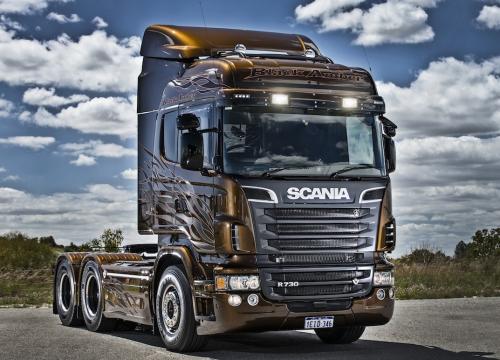
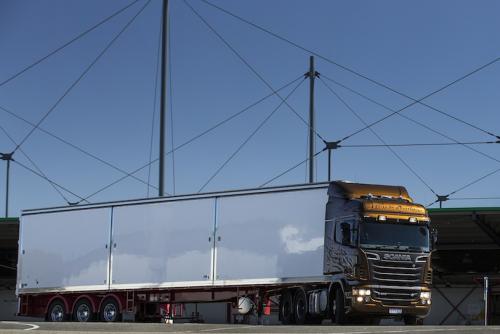
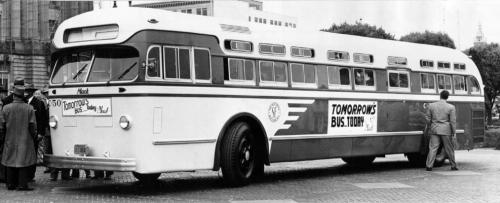
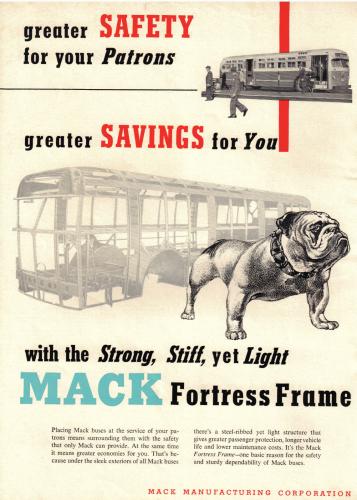
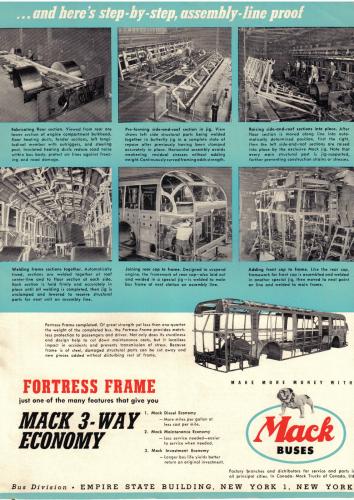
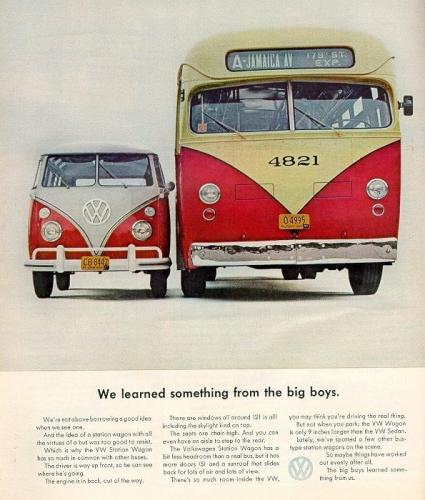
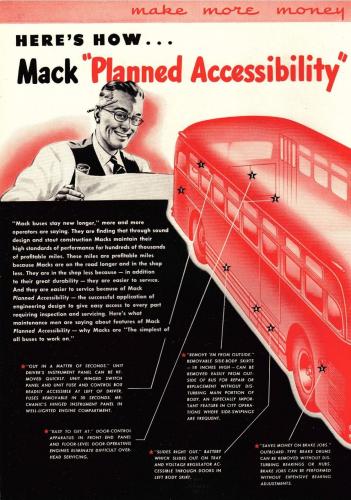
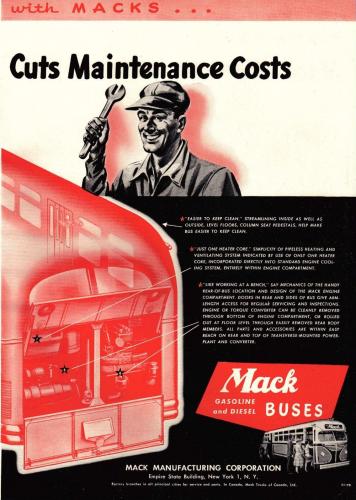
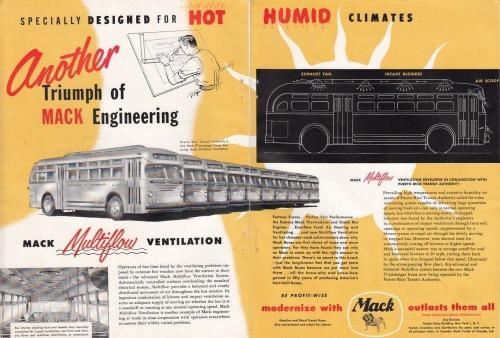
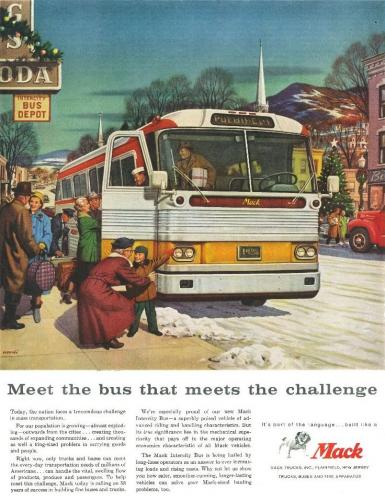
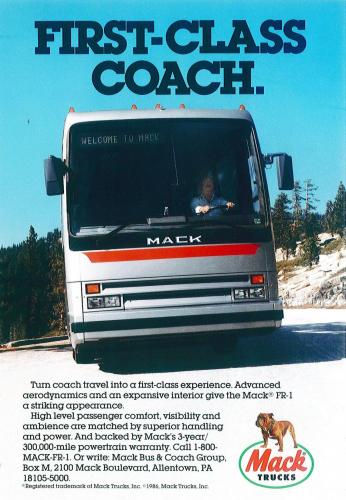
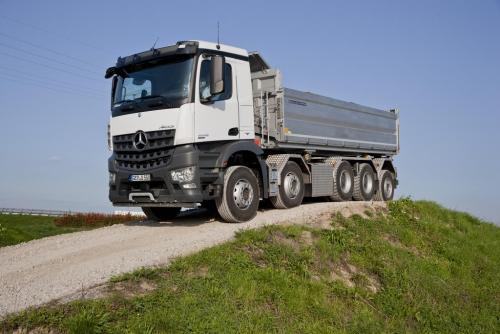
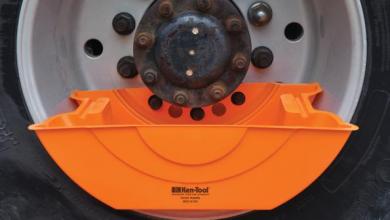
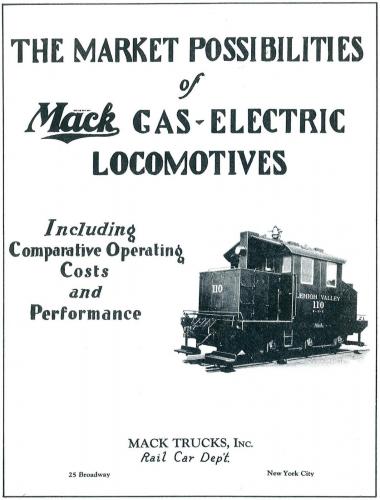
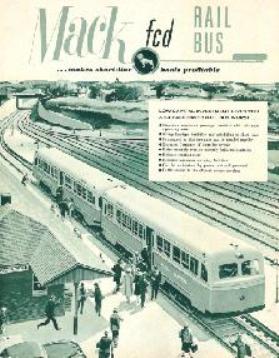
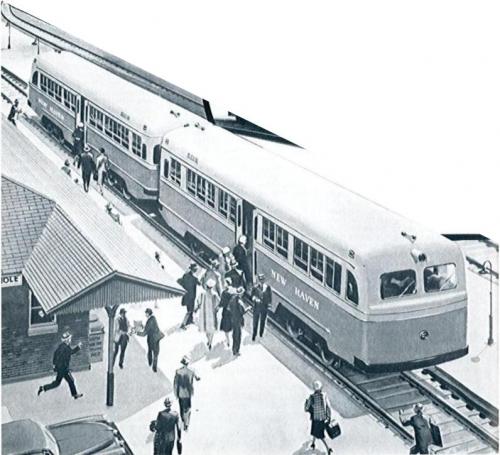
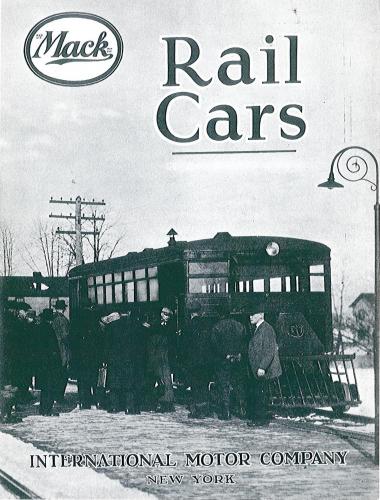
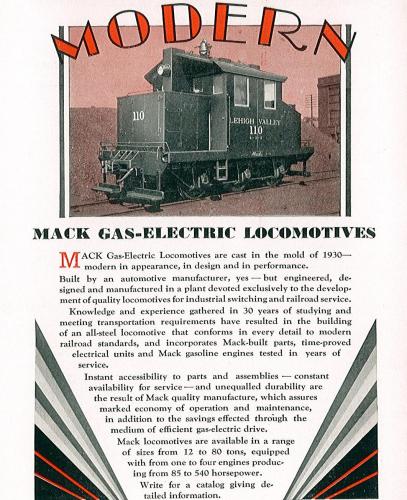
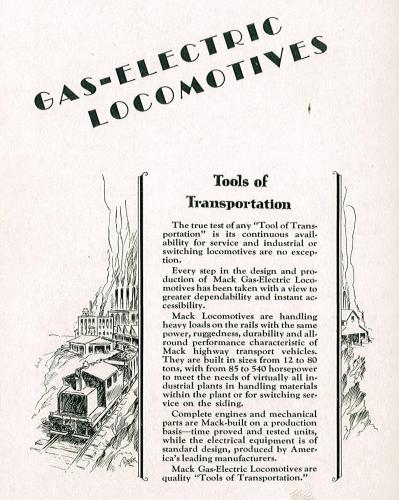
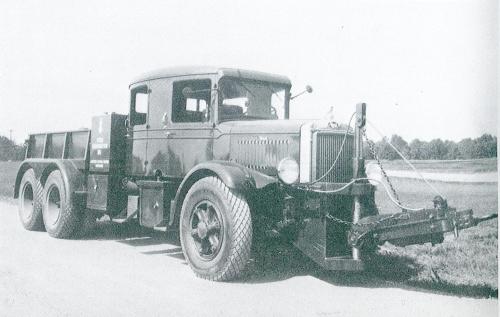
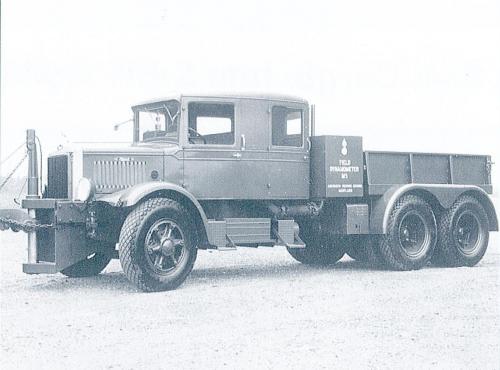
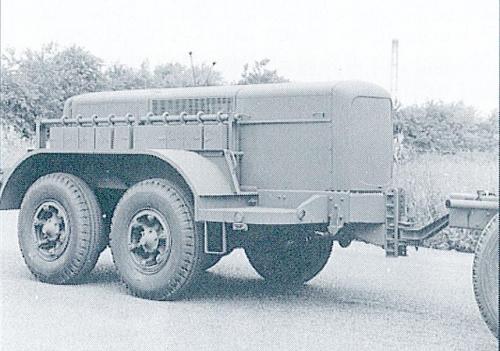
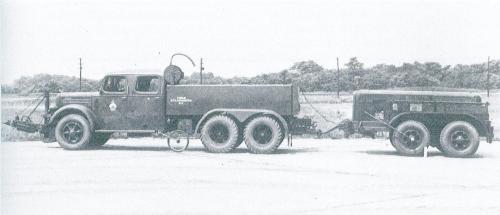
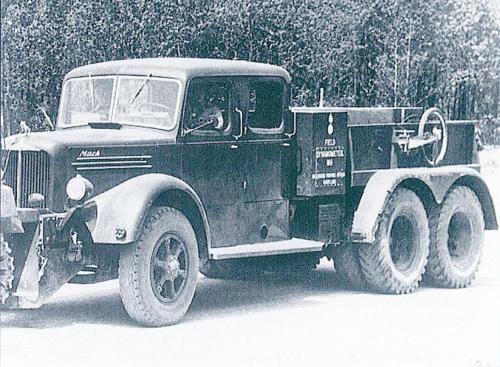
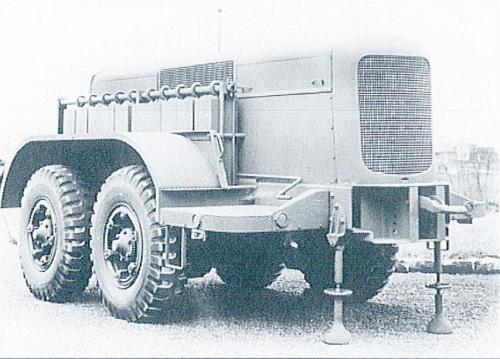
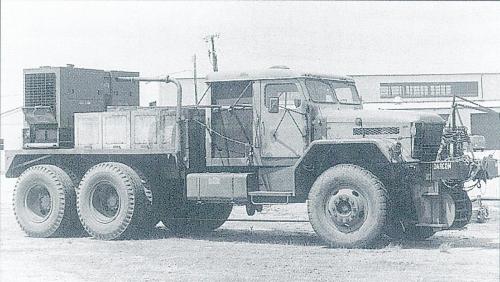
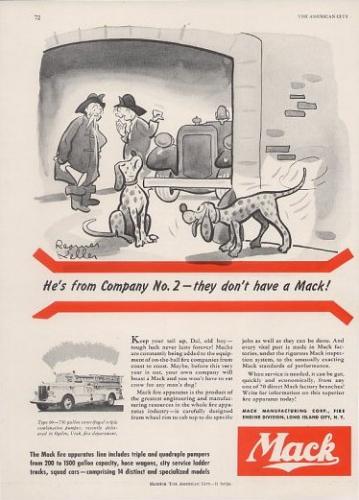
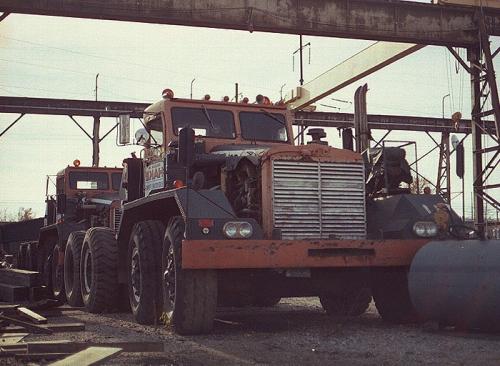
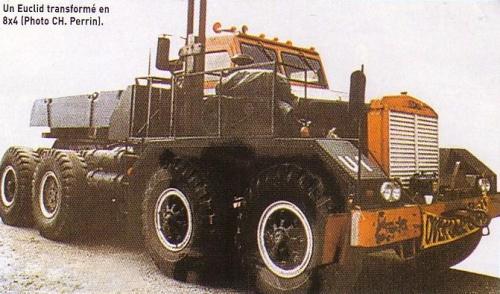
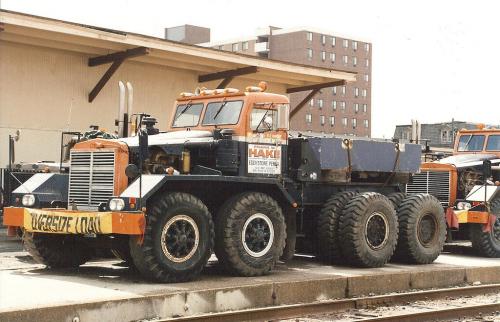
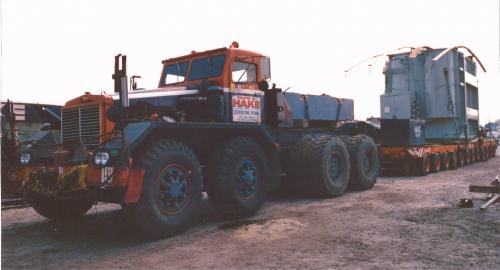
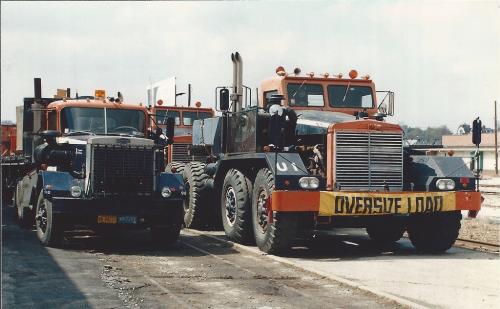
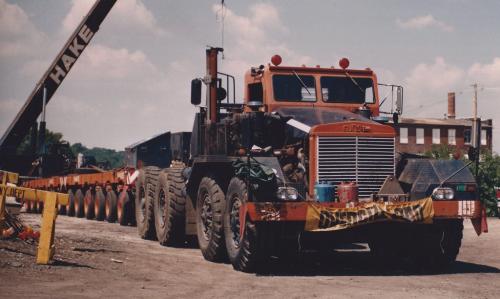
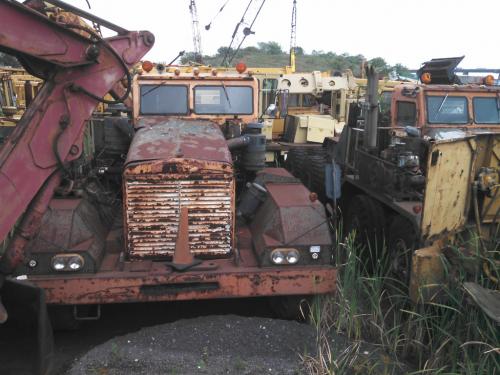
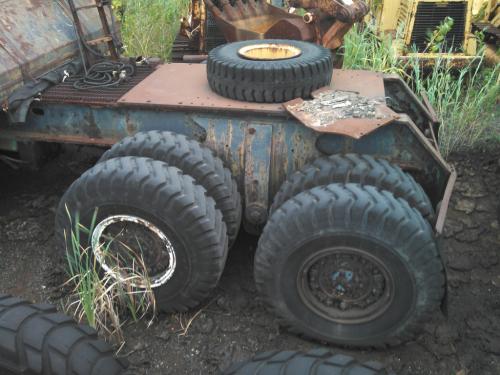
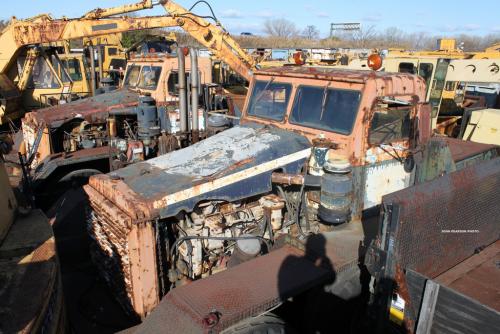
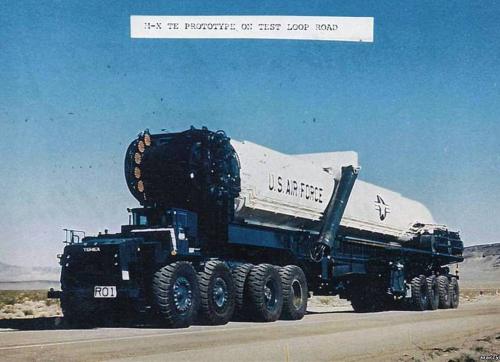
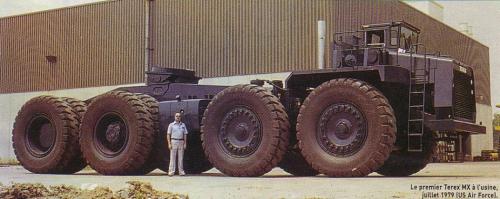
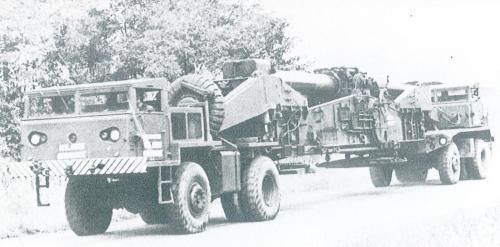

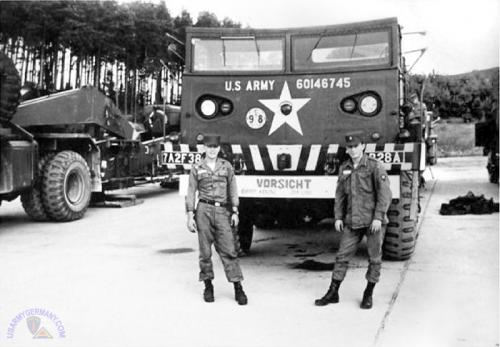
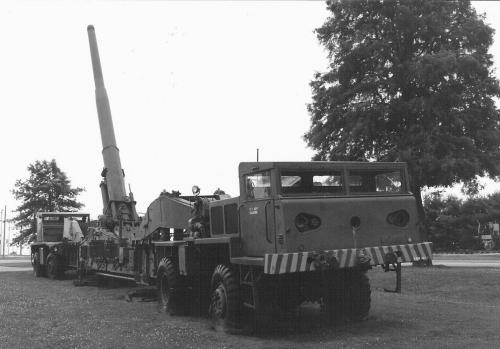
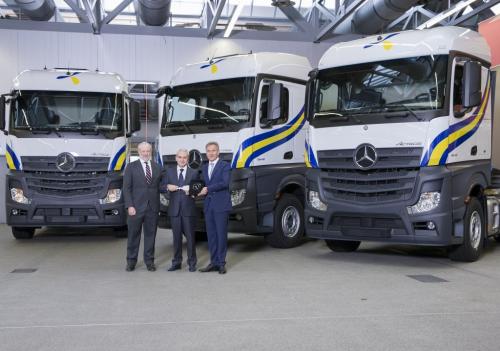
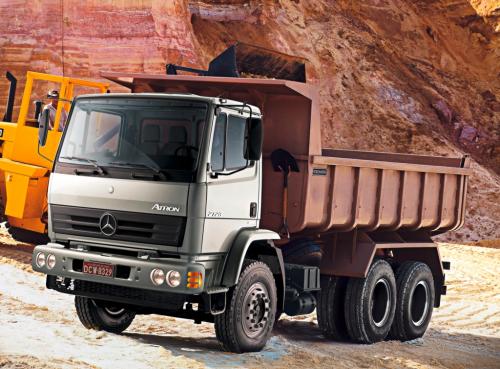

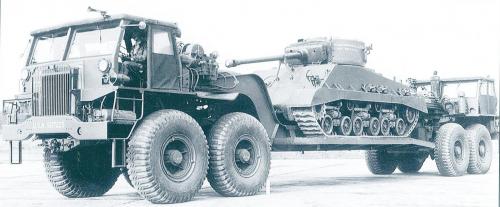
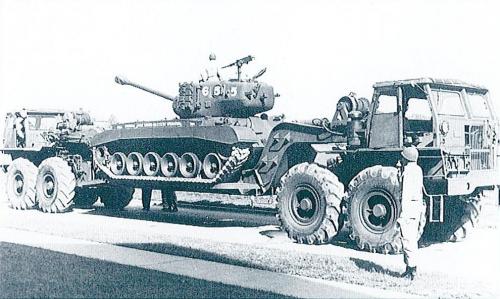
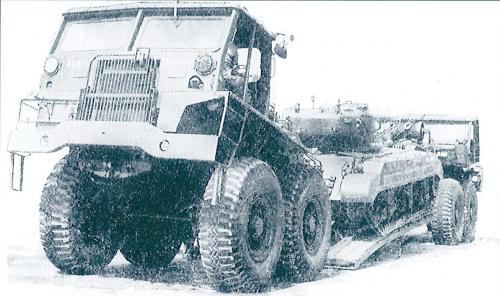
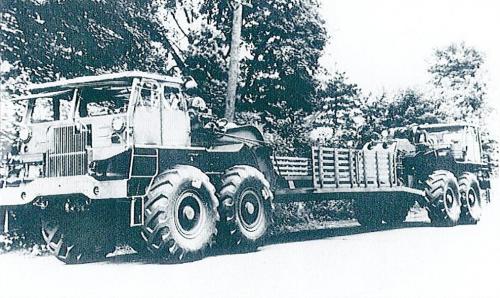
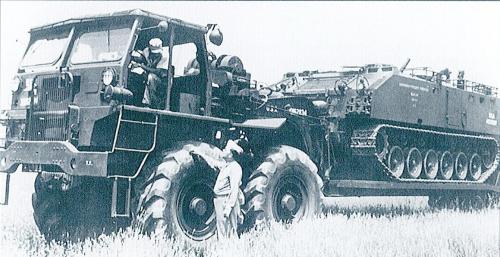


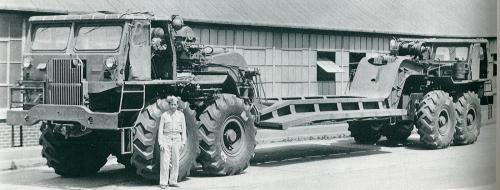
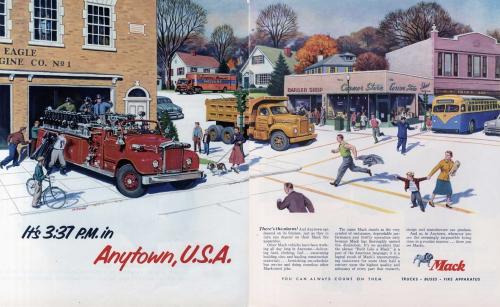
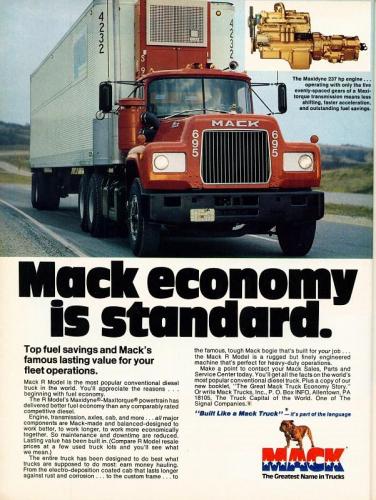
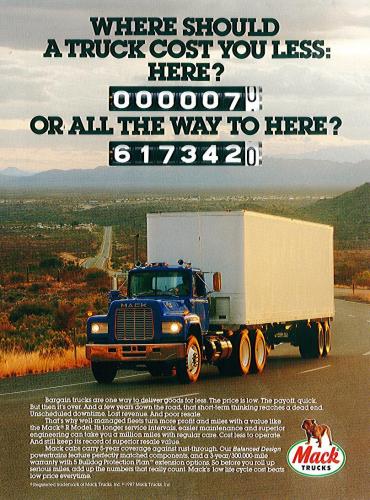
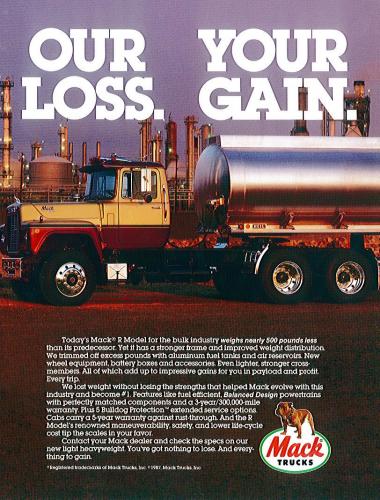
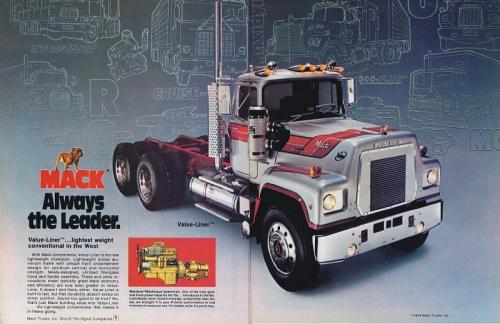
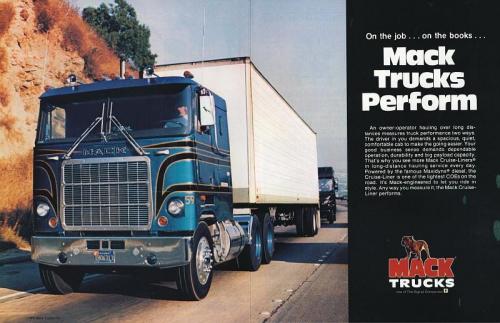
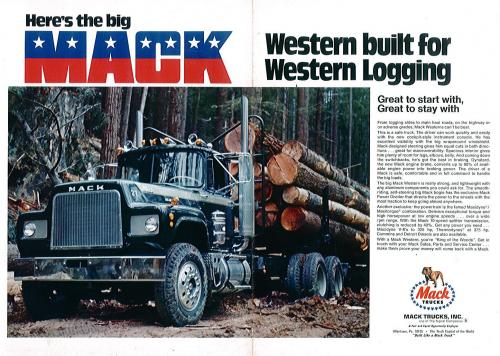
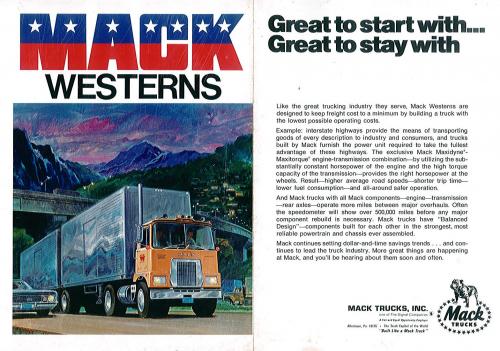
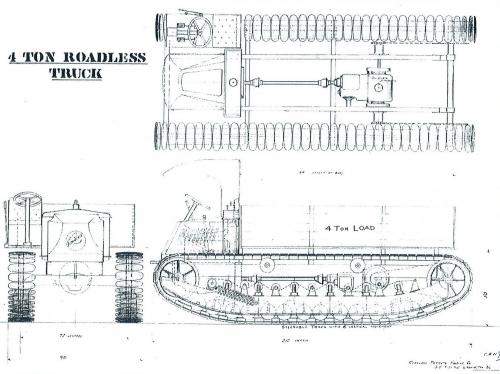
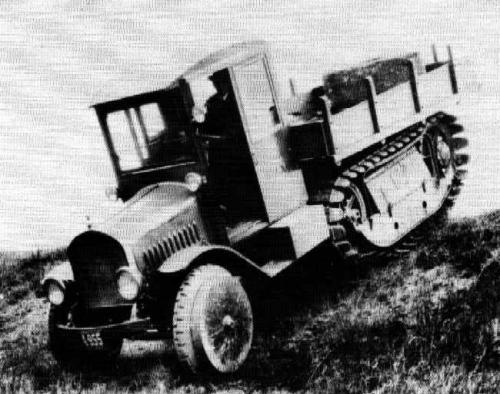

Western Star Debuts New All-Wheel Drive Truck Model
in Trucking News
Posted · Edited by kscarbel2
Transport Topics / Novermber 7, 2013
Daimler's Western Star truck unit has announced availability of an all-wheel drive version of its 4800SB model in an 8x8 axle configuration.
The truck is available with power ratings from 350 to 470 horsepower and 1,250 to 1,650 pound-feet of torque.
The truck is spec’d with a 57,000-pound tridem rear and a 23,000-pound front axle, and has an air ride suspension, Western Star said. It features a 109-inch bumper to back-of-cab distance.
Designed for use in extreme off-road conditions, the truck is equipped with a 2-speed transfer case. The transfer case is equipped with integral air shift controls for front-axle engagement and features helical gears with constant mesh.